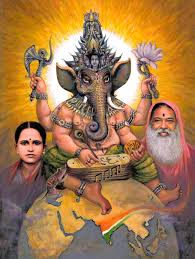Devotion is of 9 types, of which 5 are most important. The feelings (rasas) with which one offers the services to the Guru or God determine the classification into which they fall. Such feelings are: shanti rasa, dāsya rasa, sakhya rasa, mādhurya rasa and vātsalya rasa.
Shanti rasa: Keeping the mind eternally at peace, without even an iota of deviation and offering services to the Guru with this mindset is called shanti rasa bhakti.
Dāsya rasa: In this, the devotee whole-heartedly considers the Guru to be his master. Believing himself to be a servant (dāsa) of the master, he abides by the orders of the master and executes them without entertaining any other thought. There will be no irritation, no anger; the mind is totally and endlessly focused on the services to be offered. As a servant, there will be no fatigue also.
Sakhya rasa: Offering services to the Guru while treating Him as a true friend (sakhya) is sakhya rasa. Due to the feelings of true friendship the devotee shares his happiness and sorrows with the Guru and strengthens the friendship. He treats the Guru as his well-wisher. On the strength of this friendship, he offers the services needed.
Mādhurya rasa: The person who possesses the gift of the gab, talks very sweetly to the Guru, and shows Him the best possible respect while offering services to Him, this is madhurya rasa. The person will be very sharp and witty.
Vātsalya rasa: Treating the Guru as his/her child, and offering services to the Guru with the same love, affection and tenderness as shown to the child is vātsalya seva.
Offering services complete with all the 5 rasas is called pancha rasa seva.
Bhaktimala Oct 1986
